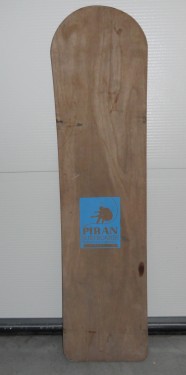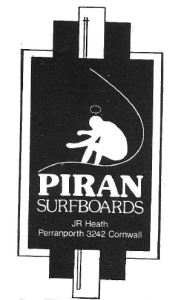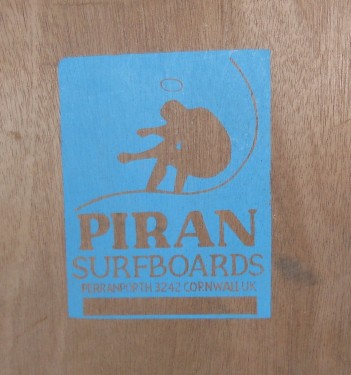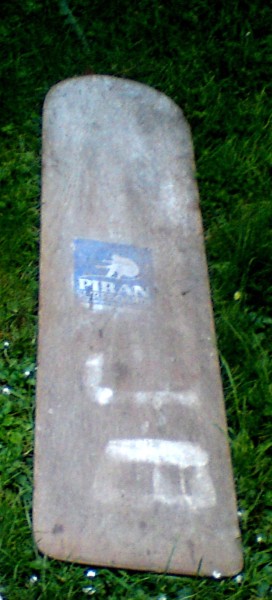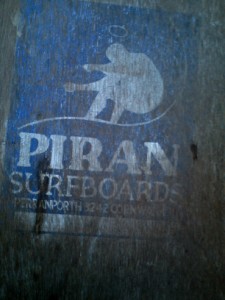A Paipo Interview with John Heath
April 18, 2011 - Perranporth, Cornwall (UK)
E-mail interview with questions by Bob Green
John prefers to ride a style of bellyboard that has been referred to as
a "coffin lid." At 70 years old he still has the "bug." In addition to
ridiing a bellyboard his family hardware firm diversiified into making
bellyboards and selling surf gear. John also shares some of the
techniques involved in riding an English bellyboard, a tradition carried
on by his sons and others, young and old.
1. When and where did you
first surf a bellyboard?
At the end of World War II, when Perranporth was still not a holiday spot
and the dunes at the back of the beach were still a minefield, we had
to crawl under a barricade of scaffold pipes and barbed wire to reach
the sea!
2. Were there many other bellyboarders at the time?
At that time only a handful of local people surfed and of course there
were no wetsuits -- here in Perranporth the water is rather chilly --
8/9°C deg (46-48°F) in late March and 17/18°C (63-64°F) in late
September. I've lived here most of my life (except a
period at University in England and then some paid employ) and have
surfed bellyboards since before I can't remember. Taught by my Mother
(born 1914).
What did your mother's instruction consist of? Did she
ride and other members of the family ride a bellyboard?
My Mother (Jennie nee Rilstone) surfed as a child of less than ten
years as did her two elder sisters and so did my three younger brothers
(now all living in NSW). My Mother stopped at age 85, when she found
getting up from the shallows was too much like hard work. Her
instructions were like those of most parents "watch me and do the
same."
|
|
John and a coffin lid at the 2004
UK World Bellyboard Chamionship
in a
borrowed Manly March Past swimsuit.
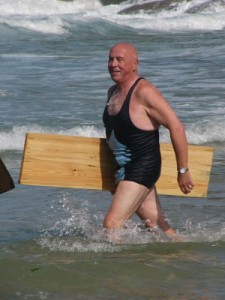
Photo courtesy John Heath.
|
3. What was your first board? Was this board typical of those
ridden at the time?
Very similar to the ones in the postcard below thou "cut down" for my
small frame
Whilst I can ride any woodboard (or bodysurf) I most often use what I
started on. That's a board made of two pieces of groove and tongue soft
timber held together by three cross pieces. This is about 5 feet long and
13 inches wide and I can catch just about anything with it though I really
only enjoy riding green waves.
Postcard of surfers at Perranporth circa 1920s.
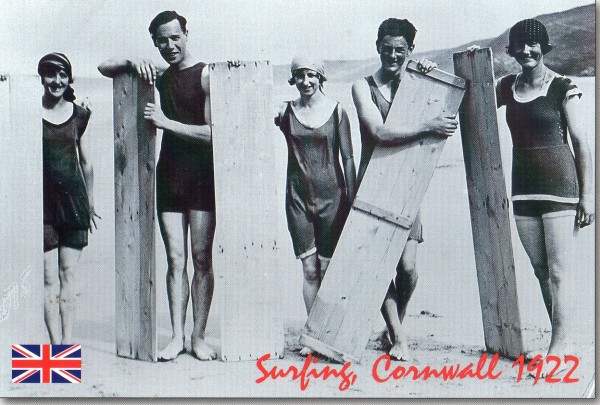
Figure courtesy of John Heath.
4. What other styles of bellyboard have you ridden?
A surf mat which I found a most unrewarding experience and a variety of
Tom Morey's boards.
5. Why do you prefer the tongue and groove style of
board?
I guess it is actually easier to catch a green wave with a longer board?
All regular boards now are made from sheet ply found in 8ft x 4ft
sheets so its only economical to cut 8 boards at 4 foot long and 12 inches
wide. Smaller boards are usually the result of a 4-foot one broken in
bending the nose after steaming.
John Heath at the 2009 World bellyboard championships [see Note 1].
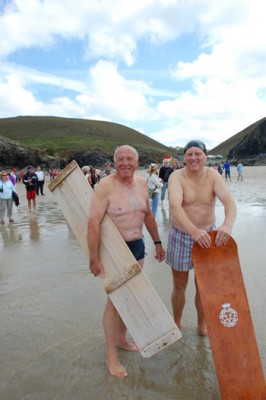
Photo from article:
Wegener, Tom. (2009, September 16). The World Wood Bellyboard Contest. Drift Surfing. Retrieved May 04, 2011, from http://www.driftsurfing.eu/index.php/archives/2030.
6. What type of wave is best suited to your board and
are there any waves or surfs that stands out from over the years?
Here there are big tides (today the rise is 7 metres) which gives very
flat, firm beaches and the Atlantic has waves quite close together
making for a hard paddle out. Best conditions for us are south or
south-east winds producing swell.
As a generality the majority of bellyboarders favour length of ride.
This is because here on the north Cornish coast the tidal rise and fall
will be between say 5.5 and 7.6 metres which produces a very shallow
fleeting beach with long "runs" of surf. Added to that our prevailing
winds are mostly from the southwest to north quarter so waves are often
broken and messy so finding accessible clean corners is difficult and
making for hard paddle out. When winds switch to the east to south
quarter with low pressure out in mid-Atlantic the waves form well and
provide decent clean waves and rideable corners - not often enough. The
notion of "peaky beach breaks" is not one we enjoy.
Memorable waves - returning to the beach after school sports in Truro
in hot weather (hot for us that is) came over the hill and saw that a
sea mist had covered the beach/surf (a temperature inversion phenomenon) -
undaunted entered the water following the course of a small stream anf
some ninety minutes later left the water (it was now about low water)
quite unable to recognise my location as I was then some 1.5 miles from
where I'd entered.
John out the back paddling onto a left, ca. 2003.
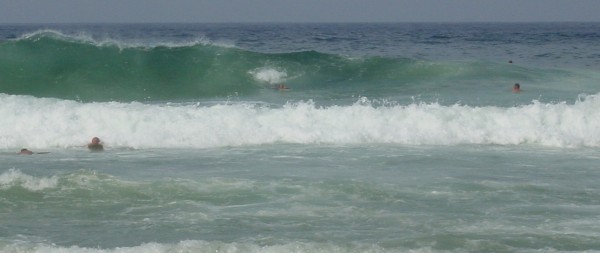
Photo courtesy John Heath.
7. When did you first get a wet-suit and do you ever use
swim fins?
Made my first in 1969, from a sheet of French "nepex" which came with
the shape of the body panels marked out. These panels were cut out and
the long-john assembled by butt sticking. This was followed by cutting
it again to make it fit, re-sticking and then taping the joints with
some rubbery tape. It was a "life-changing experience" and encouraged me
to make a jacket soon after to go diving. That suit lasted many years,
being cut down for small people, and than passed on to friends. From
time to time I use fins and a 4-foot board.
8. I've heard of a one arm paddle technique to get to
to the line-up and catch waves. From where was this technique learned? Do
you use this technique?
My style is to hold the board across my body and duck dive with it, and
yes, its fine for cut-backs. From time to time I use fins and a 4-foot
board.
Holding the board across your body and duck-diving
would seem to present more surface area for a wave to push against. Can
you describe how you achieve this move and why it works? Was this something
you worked out yourself or a traditional technique?
Think of the "vanes" on a submarine - they give lift or dive don't
they. Imagine holding the bellyboard across your body then put both
hands on the same (further) rail and roll the board until it touches
your forearms then you can angle the board to judge a depth of dive to
suit the oncoming wave.
9. What technique is required to turn and ride a tube on
your board?
Just weight the board in the direction of turn. Pressure exerted from
the appropriate elbow gives precise control of direction.
10. How did Piran Surf first get established?
Our family business was a hardware store (though we referred to
ourselves as ironmongers). But the advent of sheds (like Mitre 10)
caused us to look for new directions and in 1971, we bought some moulded
boards ( 6'7" S-decks) and long-johns and started hiring. The rest is
history.
Piran bellyboard - probably ca. 1970s. In center is the Piran Surfboards logo from a magazine advertisement.
Sources: Board photos
courtesy of the Museum of British Surfing. Center figure: Piran
Surfboards [Advertisement]. (1977, Summer). Surf Magazine, xx(x), 10. Courtesy of Henry Marfleet.
30-year-old Piran bellyboard.
Photo courtesy of Andy Bick.
11. Was there one style of board sold or did you have
different types of boards? How many boards do you estimate were sold?
Now they are waterproof ply, but we have bought solid elm boards (in the
post-war shortages of materials) and sold some elegant but fragile
balsa boards after Thor Heyerdahl's epic
voyage(one still in my garage).
In the "heyday" of bellyboarding, in the late-1960s and the 1970s, we used
to sell more that 100 wood boards a day. Remember there was no
alternative except a mal.
John and fellow bellyboarders
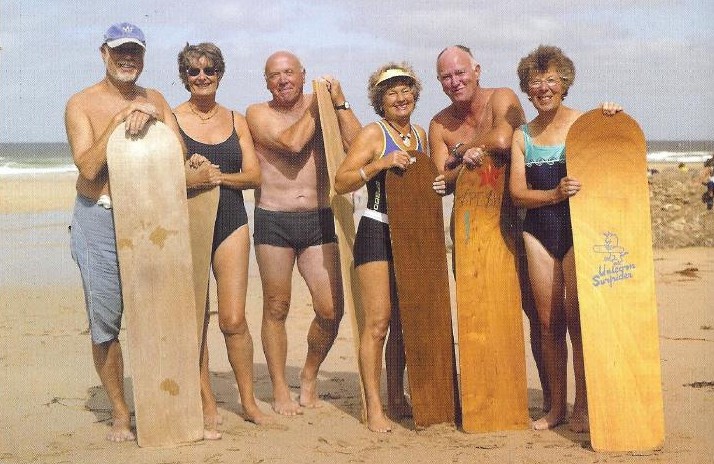
Pictured from the left are: Gerry Hunt, Janet Heath, John Heath, Ann Horton, Robn Ross, Brenda Williams.
Source: van der Bij, N. (2006). Silver surfers unite. Cornwall Today, Septemrber 2006, 40-44. Provided courtesy of Sally Morgan Moore.
12. What has been the attraction for you of riding a
bellyboard?
It's a bug - once bitten you can't forsake surfing.
|
Note 1: This contest was first
held in 2003, to commemorate the death of Arthur Traveller in 2002, and
is held at St. Agnes in September of each year. Source: van der Bij, N.
(2006, September). Silver surfers unite. Cornwall Today. pp. 40-44.
Additional Information. English bellyboards
have been documented in books such as
The above links will take you to WorldCat, the the world's largest network of library content and services.
Covers for You and your surfboard and Surf-riding on the Atlantic Coast
|
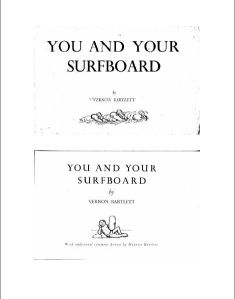
|
|
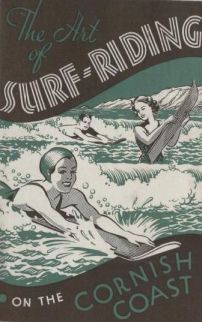
|
For more information on the above booklets, see the MyPaipoBoards Annotated Bibliography. |
|
|




